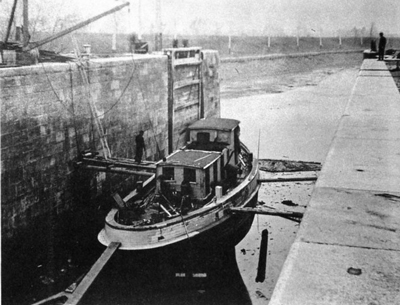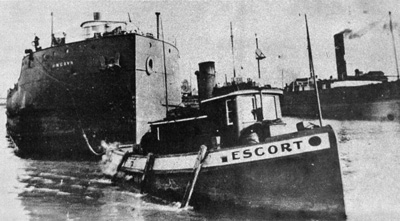Table of Contents
The restricted waters of the Great Lakes have always been a tug operator's paradise, as narrow channels and congested harbours have forced the use of tugs to assist the passage, docking, turning, etc., of lake ships. Tugs are still much in use today at various lake ports despite the advent of bow and stern thrusters, Kort Nozzles, and the like, but today's version of the harbour tug bears little resemblance to the snorting little steam tugs which once were so prevalent all around the lakes.
The third Welland Canal was a heaven for the tugman. A twisting, narrow channel interrupted by a great many small locks and choked with unbelievable ship traffic, it presented serious problems to the crew of a cargo barge or sailing vessel wishing to transit the waterway. As the day of the horses on the towpaths waned, the steam tug came into her own and was a vital part of the canal scene right up until the opening of the fourth canal in 1932. The names of the canal tugs are indelibly engraved on the memories of all those who frequented the canal in the early days of this century, amongst the most famous of them being AUGUSTA, ESCORT, ALERT, GOLDEN CITY, MARY R. and J. R. BINNING, the latter the last to survive.
ESCORT was a pretty little tug, typical of harbour tugs of the day. She had a wooden hull measuring 44.8 x 15.5 x 9.7 and her tonnage was 40 Gross and 27 Net. She was powered by what is believed to have been a noncondensing steeple compound engine which produced all of 24 horsepower on the shaft. Her boiler, of unidentified species, ate copious quantities of coal to produce this remarkable horsepower.
ESCORT, registered for her entire life at St. Catharines and the proud possessor of official number C.97010, was built in 1894 by Ross at Port Colborne. Her original owners were the Carter Brothers of Port Colborne but for most of her life she was owned by the Welland Canal Tug Company Limited of the same town, a firm with which DeWitt Carter and his brother(s) were probably associated.
That ESCORT was so small and had such little power was not at all unusual. She was not meant to battle lake gales nor to haul the big upper lakers. But what she did do, and with considerable success, was to shove barges and schooners in and out of the small canal locks and she was built to diminutive dimensions to allow her to get right in the locks with her charges, angling across the head or foot of a lock when the gates were closed.
Indeed, ESCORT was built for one purpose only and that was to solve a major problem which had arisen to face the canal authorities. In 1890, the Montreal Transportation Company Limited had built at Kingston the 242-foot four-masted schooner MINNEDOSA, the largest and finest sailing vessel ever operated by Canadians on the Great Lakes. The difficulty was that MINNEDOSA had somehow to be wedged through the small locks of the third Welland Canal, a major feat in the open channels but a nearly insurmountable problem in the locks which were not much longer than was she. ESCORT was built to be the escort through the canal for MINNEDOSA and it was thus that she came by her name.
MINNEDOSA was finally lost on Lake Huron on October 20, 1905 when she fell victim to a gale while in tow of the steamer WESTMOUNT (I) whilst off Harbor Beach, Michigan. Despite this unfortunate and much lamented event, ESCORT carried on and passed during the First World War to the ownership of the Montreal Transportation Company Ltd. whose barges still frequented the canal and kept its tugs busy.
Control of the M.T.Co. had passed in 1916 to Roy M. Wolvin, one of the principals involved in the earlier formation of Canada Steamship Lines Ltd., and in 1920 Wolvin sold the Montreal Transportation fleet to C.S.L. ESCORT went to C.S.L. as part of the deal but she did not last long with the fleet as the larger company very shortly weeded from its ranks of acquired ships those which were no longer economical to operate, namely many of the wooden steamers and assorted barges.

it is early spring in 1908 and ESCORT's rebuilding is well underway in a lock on the third Welland Canal. She shared the dry lock with tug ALERT.
ESCORT was accordingly sold in March of 1921 to John J. Harrigan of Port Dalhousie who continued to operate her along the Welland Canal. Her career for Harrigan was uneventful except for an accident near Welland in 1927 when ESCORT was sunk. She was raised shortly thereafter and repaired.
But with the opening of the new Welland Canal, there was virtually no need for tugs of the size and power (or lack of same) as ESCORT and, her wooden hull showing the ravages of time, she was scrapped at Port Dalhousie in 1937. This procedure for a wooden tug meant only the removal of any valuable pieces of equipment. The hull itself was laid to rest along the shore of Muir's Pond above old Lock One at Port Dalhousie.
ESCORT's major claim to fame, apart from her years of dependable service, arises out of an incident that came to pass seventy years ago this autumn. It was not a happy event and, indeed, it was a miracle that ESCORT ever survived to see further service. Her engineer and a crewman were not so fortunate .
On November 23, 1907, the Montreal Transportation Co. Ltd. steamer WESTMOUNT (I) was heading up Lake Ontario with the 172.6-foot wooden schooner-barge BENJAMIN HARRISON in tow. When the tow approached the piers at Port Dalhousie, a signal was made for a tug to come out and take the HARRISON in tow for the canal passage. It was the custom of the canal tugs to wait in line and to take turns in going to the assistance of incoming vessels. This particular day, it was the turn of GOLDEN CITY to go out for the HARRISON but, as tugmasters were sometimes wont to do, the skipper of ESCORT thought that he would race GOLDEN CITY out in the hope of reaching the barge first and getting a line aboard her.
All went well, the two tugs racing to the barge and jockeying for position, until ESCORT cut in on her rival and in so doing got a bit too close to the bow of the still-moving barge. ESCORT at that point was broadside to the HARRISON'S bow and she could not get out of the way in time. The HARRISON struck the hapless little tug and rolled her over on her beam ends, ESCORT heading rapidly for the bottom once she began to fill. The crew leapt into the lake except for the engineer and another man who were trapped below and who were drowned. The others were, in due course, fished from the cold lake.
ESCORT was raised not long after the accident and, with the assistance of two gatelifters, the battered remains were brought into Port Dalhousie. She was taken up the canal to one of the locks in the St. Catharines area and when the canal was dewatered for the winter, she was propped up in the bottom of the lock along with her consort ALERT. Over the winter, ESCORT was completely rebuilt and emerged in the spring of 1908 looking not much different than she had prior to the accident. Her superstructure was virtually new as it had been almost totally demolished in the sinking but it was rebuilt almost exactly as it had been before, tugboat architecture not having changed much in the fourteen years since she had left her builder's yard.
ESCORT'S misadventure received much publicity, no doubt because of the fact that she was such a familiar boat along the canal and was sailed by local men. In fact, there even appeared a memorial postcard to commemorate the unhappy event. A copy of this card is reproduced on our photopage.
It is now seventy years since ESCORT's escapade with the BENJAMIN HARRISON and more than forty since the little tug last operated. With her bones still rotting away at Port Dalhousie, it is fitting that this workhorse of the canal should be remembered so many years later.
Previous Next
Return to Home Port or Toronto Marine Historical Society's Scanner
Reproduced for the Web with the permission of the Toronto Marine Historical Society.
